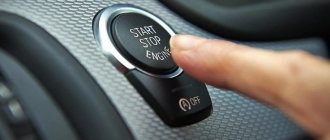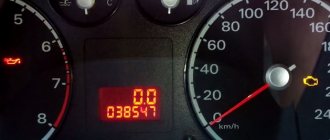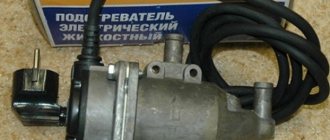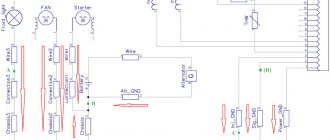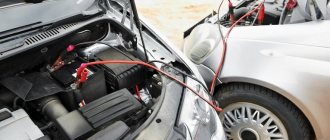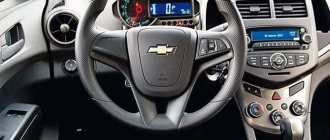Gross mistakes made during the operation of a car always have consequences that appear either immediately or over time. This applies even to the most common action for every driver - starting the engine. How to start a car with an automatic and manual transmission, are there separate instructions for starting it in the winter, is it possible to start it if the battery is dead?
Even starting the engine, which falls into the category of simple operations, can provoke a real panic attack in a beginner. Engineers have tried to make this process as simple as possible for both manual and automatic transmissions. What does the step-by-step procedure look like in both cases and how to start the car in winter?
Car with manual transmission
Before attempting to start the car, check and adjust all mirrors and make sure that everything you need while driving is within easy reach. Don't neglect safety rules, so buckle up and follow the step-by-step instructions that will ensure you know exactly how to start a car with a manual transmission.
- Check the position of the parking brake; it should be up.
- Check the position of the gear shift lever; it should be in neutral and move freely left and right.
- Depress the clutch pedal to make starting the engine easier. In some cars, without this step, you will not be able to start the engine with the key.
- Insert the key into the ignition and turn it clockwise to activate the ignition system (read about how to start a car without a key). At this stage, the machine is being prepared for start-up, which will be indicated by the lights on the instrument panel turning on. If the engine is fuel-injected, wait 5 seconds while the fuel pump pumps fuel to start the engine. If the car has a carburetor, pull the choke towards you.
- Turn the key clockwise and hold it in this position to engage the starter. Wait 1 5 seconds and the motor will start if everything is ok in the system. Repeat this step after a minute if nothing works, but do not turn the starter for more than 5 seconds, otherwise the spark plugs will flood with fuel and the battery will be discharged.
- After starting the engine, wait until it warms up. This stage cannot be neglected in the cold season, since a warmed-up engine gains speed better, develops power and demonstrates stable operation.
You can read more detailed information about how to drive a manual car correctly in the material from our specialist.
Operating principle of gasoline and diesel engines
Many people have probably noticed that running diesel cars make noisier sounds. This is due to the fact that the starting of the internal combustion engine is implemented differently in gasoline and diesel cars.
The principle of starting a gasoline engine is the ignition of the fuel mixture in its cylinders. When you turn the key in the ignition, a spark appears, the fuel-air mixture ignites, and thermal energy is released. Thanks to this, the operation of the internal combustion engine mechanisms is carried out.
A diesel engine is similar to a gasoline engine. However, the fuel in it ignites differently, due to the lack of an ignition system. The diesel engine operates using high pressure.
The air is compressed and becomes very hot, then fuel is supplied to the combustion chamber. There it spontaneously ignites. This is why there is such a high level of noise, the car seems to “rumble” - it is produced by the ignition process.
In the cold season, such engines start with difficulty. This happens precisely because of its design feature; compressed air cannot reach the ignition temperature of the fuel. But such cars use diesel fuel, which is cheaper than gasoline.
Therefore, in order to start both cars correctly, especially in the cold season, you need to know some nuances.
Starting a car with an automatic transmission
An automatic transmission requires protection against incorrect starting, so such protection was immediately invented in tandem with the gearbox. If you don’t know how to properly start a car with an automatic transmission and this is your first time behind the wheel, you will struggle with the ignition.
Traditionally, starting an engine with an automatic transmission occurs as follows.
- The speed selector must be set to parking mode (P).
- Squeeze the brake pedal, do not release it, and start starting the engine.
- Insert the key into the lock and turn it until you hear a click. At this stage, the fuel pump starts and the indicators on the dashboard light up (read how to open a car door without a key).
- Turn the ignition key when the lights go out until the starter starts. Release the key and it will return to its original position.
- If the engine refuses to start, you can make a couple more attempts at intervals of half a minute.
- Move the selector to position D or R, taking into account the desired direction of travel, after the gearbox has warmed up. Start driving after releasing the brake pedal.
Warming up the engine after starting is a mandatory step, since it ensures normal operation of the engine lubrication system. This is explained by the fact that the oil mist necessary to lubricate the cylinders and pistons does not form immediately.
We also recommend that you additionally read our author’s article, in which he talks in detail about how to properly drive an automatic transmission.
Warm up the car while idling. In this case, the number of engine revolutions should be slightly higher than idle speed.
Lifehacks for beginners: getting started on a slope
Hills that are found on city and country roads cause certain difficulties for beginners. Because of the upward slope, many are afraid to start moving after a forced stop. Especially if there is a car behind.
In order not to get confused or scared in such a situation, practice driving uphill. For this:
- Press the clutch and shift into first gear.
- Lightly press the gas pedal as you begin to release the clutch.
- At the same time, raise the handbrake lever a little more without pressing the buttons on it.
- At the right moment, release the handbrake so that the car moves forward.
The engine speed should be higher than during a normal start, but not too high so that the car stalls. In this way you can start moving even on a steep climb.
Are you afraid that you won't be able to learn to drive? Contact the Moscow “Driving School 177”. Our instructors will teach you how to start in different conditions. Students can use a special training area to practice skills in a relaxed environment.
How to start a car in winter
Gas engine
Problems with starting the engine begin when the temperature drops below 15 degrees Celsius. Actions for such a situation must be learned step by step.
- Turn off the heated windows, seats, heater fan, radio and other devices that are powered by the battery.
- Warm up the battery by turning on the high beam for half a minute and the low beam for 2 minutes. The recommendation will be in demand if the car is an early release model. You can repeat these steps if you are in doubt about the battery.
- Press the clutch pedal a couple of times, being aware of the fact that this is done with manual transmission cars. If the car is fuel-injected, it is prohibited to touch the gas pedal until the engine starts.
- Do not release the clutch pedal suddenly when the car starts, release it smoothly.
- If the car does not start the first time, try again at intervals of a couple of minutes.
Be sure to read a very interesting and extremely useful article on how to start a car in cold weather.
Diesel engine
During the winter season, problems with diesel engines occur most often. Therefore, when choosing fuel for refueling, give preference only to winter diesel fuel. Vehicles with diesel engines are equipped with glow plugs, which make starting the engine easier by heating the fuel. To start the engine correctly, you must perform the following steps.
- Turn on the ignition and wait until the glow plug indicator goes out. In severe frost, this step can be repeated.
- If you are sure that there are no problems with the battery, but the engine still does not start, the diesel fuel is still frozen and you need to warm up the car in a heated garage.
- If it is not possible to drive the car, warm up the fuel and oil filter area. To do this, lift the car with a jack or use a lift, pit or overpass. A construction or home hair dryer, as well as a soldering iron, are suitable as a heat source. Next, try again to start the car.
Control methods
The car's autostart system is controlled by two modes: automatic and remote. The first is to set a certain number of engine starts per night and the duration of its operation, and the second is to start using a button on the key fob. There is also the option of control via an application on your cell phone, with the condition that it is possible to change the GPS receiver to send tasks via SMS.
The battery died in a car with a manual transmission
It is also worth knowing how to properly start a car with a dead battery. This problem occurs if the battery is weak and the weather is cold or damp. The first thing you can try is a push launch. The brakes must work properly. This method involves the use of male power as a tug, a road slope or a second car. If you have a carburetor, be sure to pump up the fuel by pressing the gas pedal 3-4 times.
To do everything right, follow these steps:
- Give the command to push the car after inserting the key into the lock and turning it.
- When the vehicle accelerates slightly, press the clutch pedal and engage second gear.
- Smoothly release the clutch pedal, after which you will feel the engine starting, accompanied by a slight jolt. Speed and driver calm are fundamental success factors in this case.
- Stop the car as soon as it starts, but do not turn off the engine, let it warm up for 15-20 minutes.
You may also be interested in an article by our expert, in which he tells what to do if the car does not start and the starter does not turn.
Additionally, we recommend reading the material, which tells you how to choose a booster to start the engine.
Another useful topic is making a winch from a starter with your own hands. Read about this in a detailed article by our specialist.
We also recommend reading the material, which describes in detail the principle of making a starting device for a car with your own hands.
It is allowed to repeat the above steps if nothing worked the first time. Before using this method, be sure to make sure that the manufacturer allows such measures. You can find out about this from the manual. If we are talking about a Chevrolet Aveo, for example, then such manipulations can seriously harm the engine.
The “lighting up” method is also relevant if there is no cable or strong men to push the car. To do this, you need a second car with a working battery and special wires with clamps used to transfer energy from a working battery to a dead one.
Possible breakdowns
It should be immediately agreed that the term “long downtime” is a relative concept. Therefore, we will separately consider starting the engine after different periods of parking, including long-term storage of the car. After parking the car for a long time, the following negative factors may appear:
- Battery discharge.
- Oxidized contacts.
- The piston rings are stuck in the pistons.
- Air penetration into the power supply system of diesel power units.
- Evaporation of gasoline from the carburetor body, or draining of fuel from the tank.
In addition to these well-known situations, you can also see the consequences of animal life. Even drivers who constantly use their cars may find that hoses or wires have been chewed by rats. There is a possibility that after such parking the car will not start for a long time.
The battery died in a car with automatic transmission
Often the battery in an automatic vehicle runs out in the winter. If in the case of mechanics you can get by with a “pusher,” the machine will not react to such actions. The only effective ways are to replace the battery with a new one, charge it, give the battery a warm bath, and also “light a cigarette.”
The last resort would be to transport the car to a warm box using a tow truck, but you should avoid moving it in tow. The brake boosters do not work in a car that is not running, so it is almost impossible to depress the pedal while driving.
Let's sum it up
After a long period of parking, before starting the engine you need to:
- Replace fuel.
- Change the engine oil.
- Charge the battery.
- Inspect seals and hoses.
- Inspect the bottom of the car and, if necessary, repair any leaks.
- Replace brake fluid.
- Inspect the brake linings and pads.
- Replace spark plugs.
- Inflate the wheels.
In most cases, a long downtime of a machine leaves its consequences, which will manifest themselves someday. To reduce the risk of their occurrence, the car must sometimes be warmed up and driven a little while parked for a long time.
What to check before traveling
Before you start driving a car, you need to prepare for the trip and check the car. For experienced drivers, this procedure takes only a couple of minutes, but many beginners forget about its necessity and immediately start the car.
Before opening the driver's door, you need to conduct an external inspection of the car. Make sure that all wheels are inflated and there are no leaks under the bottom of the car. A flat tire or brake fluid leak poses a huge danger to the driver. It is also worth checking the operation of the lighting devices, both front and rear.
After you sit in the driver's seat, you need to adjust the seating position. An uncomfortable driving position while driving can not only cause inconvenience, but also prevent you from reacting in a timely manner to changes in the traffic situation.
- Adjust the position of the driver's seat. Your feet should rest comfortably on the pedals; if you have to pull your foot up to them, you need to move the chair forward. There is also no need to move the chair too much, otherwise it will be inconvenient to move your foot from one pedal to another. If the car has such a function, then you can adjust the seat height of the driver's seat.
- The position of the steering column is also important. Your arms should rest comfortably on the steering wheel in an extended position. If the car settings allow it, then adjust the height of the steering column and the reach of the steering wheel.
- Adjusting the rear view mirrors, both side and interior mirrors, is also of great importance. Don't forget about the mirror on the passenger side, it also improves rear view and allows you to control the movement of the car.
- And the last detail - fasten your seat belt and force all passengers in the car to do so.
